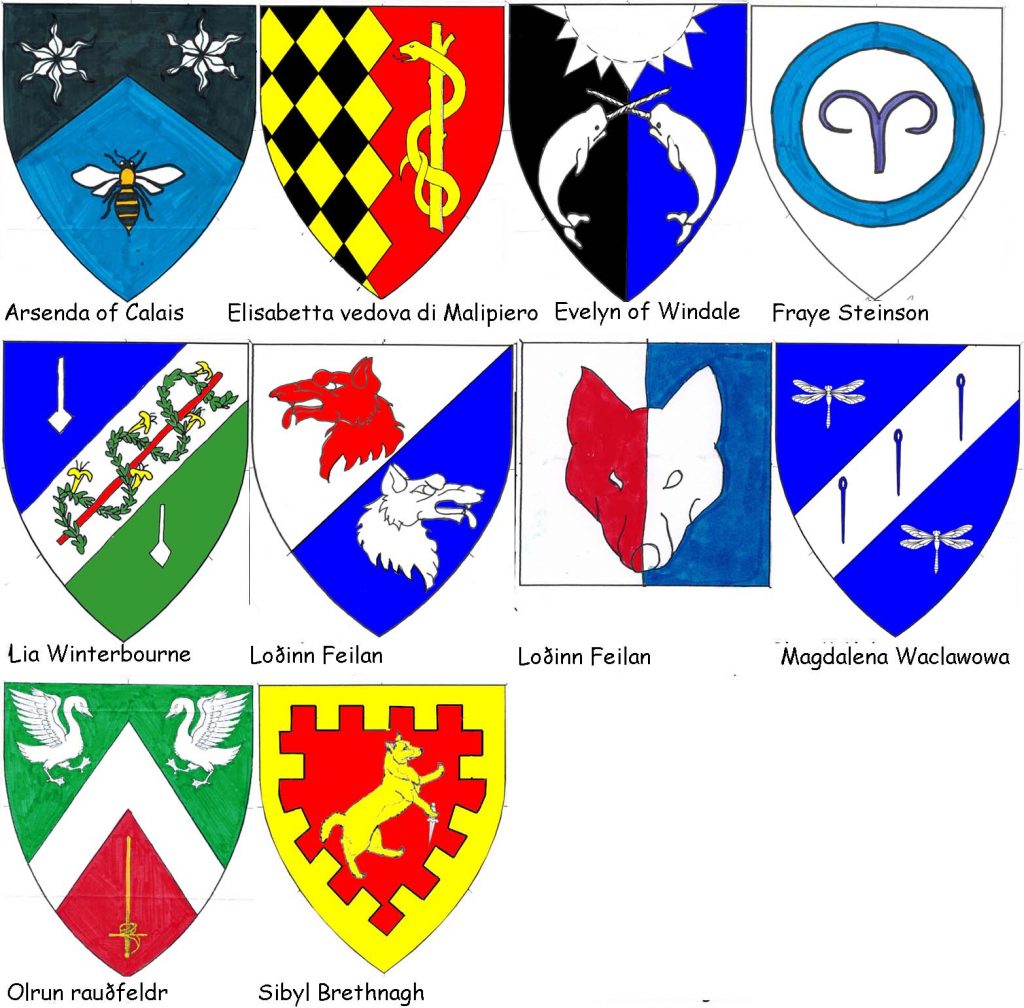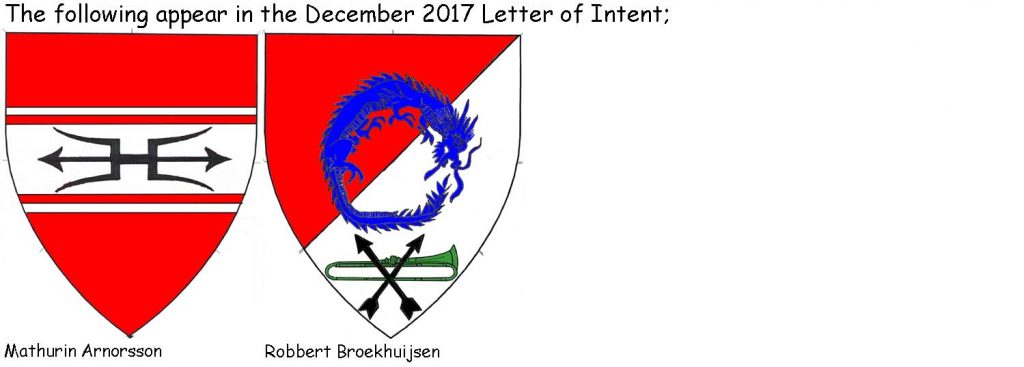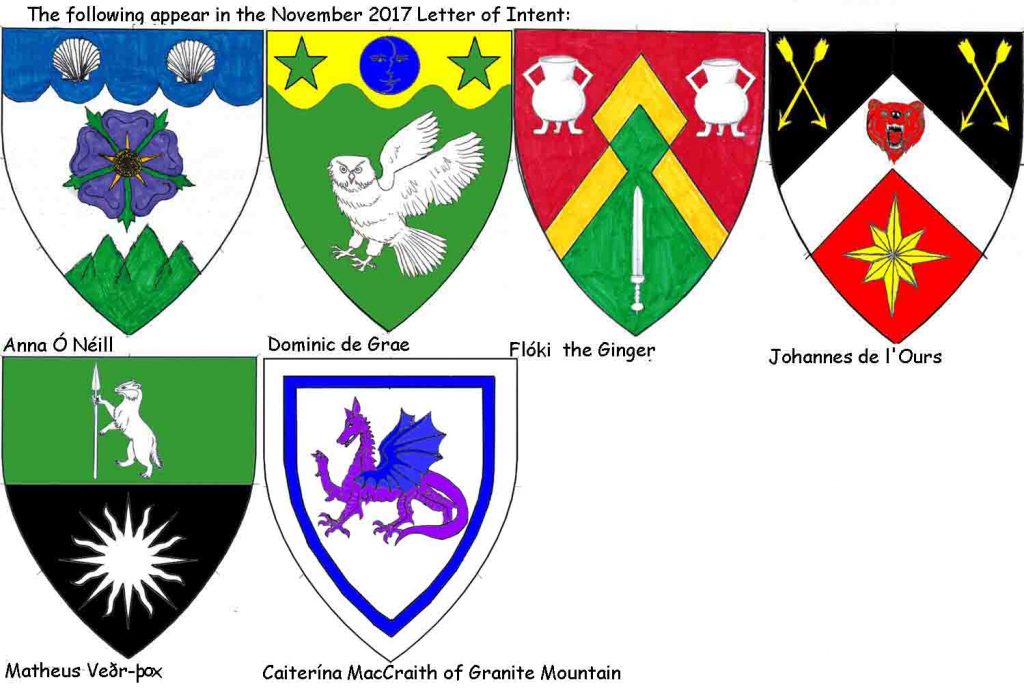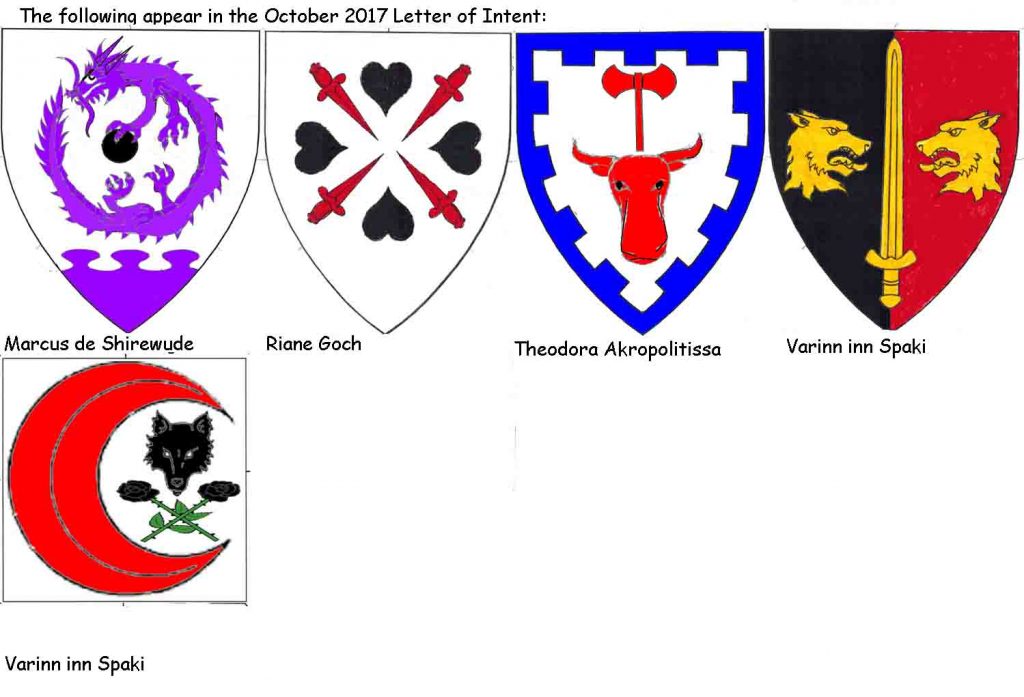ATENVELDT COLLEGE OF HERALDS 1 February 2018, A.S. LII
LETTER OF PRESENTATION Kingdom of Atenveldt
Unto Their Royal Majesties Marek and Golda; Baron Seamus MacDade, Aten Principal Herald; Heralds in the Atenveldt College of Heralds; and to All Whom These Presents Come,
Greetings from Marta as tu Mika-Mysliwy, Brickbat Herald and Parhelium Herald for the Kingdom of Atenveldt!
This is the February 2018 Atenveldt Letter of Presentation. Please have commentary to me by 25 February 2018.
Heraldry Hut: Because of the Estrella War, there will not be a Heraldry Hut in February (the War doesn’t conflict with the third Friday, but I doubt if we’ll see anyone attending). If there is one, it’s likely to be preparing for the War.
Please consider the following submissions for the February 2017 Atenveldt Letter of Intent:
Áine inghean Uí Ó Raghallaigh (Mons Tonitrus): NEW NAME
The name is Irish Gaelic. Áine is a Middle Irish Gaelic and Early Modern Irish Gaelic female given name, dated 1169 through 1468 (“Index of Names in Irish Annals: Áine,” Mari Elspeth nic Bryan,http://medievalscotland.org/kmo/AnnalsIndex/Feminine/Aine.shtml. Raghallaigh is found in “16th & 17th Century Anglicized Irish Surnames from Woulfe,” Mari ingen Briain meic Donnchada, p. 628 with the Gaelic header Ó Raghailligh, and Ó Raghallaigh, http://medievalscotland.org/kmo/Woulfe/SortedByAnglicizedRoot_P.shtml. inghean Uí is the standard way to form a name using an Irish clan affiliation byname for women (“Quick and Easy Gaelic Names” 3rd Edition, Sharon L. Krossa, http://medievalscotland.org/scotnames/quickgaelicbynames/#simplepatronymicbyname.
The client desires a female name and is most interest in the spalling and language/culture of the name (Irish, Gaelic). She will not accept Major Changes to the name.
Lucius James (BoA): NEW NAME and DEVICE
Or, a fist and a bordure rayonny Or.
Lucius is found as an English male given name as Lucius Deringe, with a marriage date 22 Sep 1578 in Wolborough and Newgon Abbor, Devon, England (Batch M05188-1, https://www.familysearch.org/search/search/record/results?count=20&query=%2Bgivenname%3ALucius~%20%2Bsurname%3ADeringe~%20%2Bbirth_place%3AEngland~). The surname James can be found with Gwilliam James’ christening date of 02 Sep 1554 at St. Thomas’, Newport, Hampshire, England, https://www.familysearch.org/ark:/61903/1:1:N2RW-LZZ.
The client desires a male name and is most interested in the language/culture of the name (English). He would like it authentic for 16th C. England.
Nichelle of Whitewolfe (BoA): NEW BADGE
Sable, a demi-panther argent spotted sable and incensed gules, maintaining a cross formy argent.
The name was registered June 1973.
Nudd McPherson (BoA): NEW NAME CHANGE from Ian Nudd MacPherson
The current name was registered December 1989, before the College of Arms allowed English surnames permitted as given names in late period. The client registered the given name Ian at the time to comply with the rules, but his preference has always been to be known at Nudd.
George Nudd is shown with a marriage date of 1582 to Margaret Feild at Yelverton, Norfolk, England, Batch M09677-1 (https://www.familysearch.org/ark:/61903/1:1:N2PF-SP2). Dowgall McPherson is shown with a 16 Sep 1649 marriage date at Kenmore, Perth, Scotland, Batch M11360-2(https://www.familysearch.org/ark:/61903/1:1:XY3C-WXY). The client desires a male name; he will not accept any Major or Minor changes to the name.
Tir Ysgithr, Barony of: NEW ORDER NAME, Order of the Ffrind of Ysgithr
The name is Welsh. Ffrind is Welsh for “friend”; it is found in English Elements in Welsh, T. H. Parry-Williams, p. 125. The name for the Barony of Tir Ysgithr was registered in January 1973. If this is registered, it should be associated with the badge (Fieldless) A maunch Or charged with a boar’s head couped contourny sable., registered to the Barony in August 2017.
The following submissions appears in the January 2018 Letter of Intent:
Commentary was provided by ffride wlffsdotter, Magnus von Lübeck, Michael Gerard Curtememoire.
Arsenda of Calais (Windale): NEW DEVICE: Per chevron sable and azure, two estoiles argent and a bee proper.
The name was registered September 2004.
The client already has a device, registered December 2005: Per chevron vert and azure, two estoiles and a winged scarab displayed, maintaining between its wingtips a roundel argent. If the new submission is registered, please release the current device.
Elisabetta vedova di Malipiero (Granite Mountain): NEW NAME CHANGE from Elisabetta Malipiero and NEW DEVICE CHANGE: Per pale indented lozengy sable and Or, and gules, a rod of Asclepius Or.
The current name was registered April 2002. The change adds the term vedova, “widow,” to the name. Per “Academy of Saint Gabriel Report 3052” by Ursula Whitcher, women could incorporate their husband’s given name into their surname. vedova di [husband’s name], meaning “widow of” is one example, found in 15th century Florentine records: Lorenza vedova di Bartolomeo = Lorenza, widow of Bartolomeo (http://www.panix.com/~gabriel/public-bin/showfinal.cgi/3052.txt). Documentation for this comes from the submission of Lisabetta vedova di Alessandro, registered December 2014.
The client desires a female name and is most interested in the meaning of the name. She would like it to be authentic for language/culture and time period, ideally 12th-15th C. Venetian. If registered, the current name is to be released.
If the new device is registered, the currently-registered one, Gules, two winged lions statant respectant Or., is to be released.
Evelyn of Windale (Windale): NEW DEVICE: Per pale sable and azure, two narwhals hauriant respectant horns in saltire and issuant from chief a demi-sun argent.
The name was registered June 2017.
The position of the narwhals is taken from the armory of Jocoff Alfanng: Azure, two narwhals haurient respectant horns in saltire argent, a chief wavy Or., among others.
With a few less twists in the horns (or a thinner line used for the twists), they would likely look lighter in color and be more identifiable as narwhal horns.
Freya Steinson (Granholme): NEW NAME and DEVICE: Argent, the astrological symbol for Aries purpure within and annulet azure.
Unfortunately, no commenters were able to find Freya as a period given name for a human. On the other hand, ffride wlffsdotter came to the rescue again:
“Fraye Hayman, female, married 1624, Germany. Batch no. M99290-1
(https://familysearch.org/ark:/61903/1:1:J4PG-C5P)
Fraye Lucknor, male, christened 1617, England. Batch no. C07002-1
(https://familysearch.org/ark:/61903/1:1:J736-JH7)
I think it can be claimed that by the 16th century, names were inherited instead of literal patronymics, hence:
Isabell Steinson, married 1582, England. Batch no. M00302-1
And this is the case: as per the February 2015 LoAR cover letter, 16th and early 17th C. German given names can be combined with an English surname (http://heraldry.sca.org/loar/2015/02/15-02cl.html#2)
Hence, it is possible for a woman to be called “Fraye Steinson.””
As for the device, “The use of astrological glyphs heraldically in period can be seen on the crest of Bull, watchmaker to Queen Elizabeth I: On a wreath argent and gules, a cloud proper, thereon a celestial sphere azure, with the circles or; on the zodiac the signs of Aries, Taurus, Gemini, and Cancer (Parker, A Glossary of Terms Used in Heraldry, p. 547). It has long been the College’s policy to allow the use of elements from crests and supporters, if period usage is documented, as charges for SCA armory although there is no documentation of their use as charges in period armory (cf. Yales),” [September 1993 LoAR, A-East] Cadell ap Hubert. The zodiac signs in a 16th-century woodcut demonstrate all the astrological glyphs: https://en.wikipedia.org/wiki/Zodiac#/media/File:Zodiac_woodcut.png
Jorunn Vakr (Twin Moons): NEW NAME
The name is Norwegian. While the given name is documented in behindthename.com (not a good source), Jórunnrcan be found in Geirr Bassi Haraldsson, “The Old Norse Name,” p. 12, as a female Old Norse name. Additionally, Diplomatarium Norvegicum (http://www.dokpro.uio.no/dipl_norv/diplom_field_eng.html) vol. II no. 285 (dated to 1347) mentions “Arne Þrondar son ok Jorunn moder hans” (Arne Þrond’s son and Jorunn his mother) as a Norwegian name (this was provided by Aryanhwy merch Catmael).
Vakr is found in https://www.nordicnames.de/wiki/Vakr. Vakr is a male given name in Geirr Bassi, p. 15, as an Old Norse name. This name appears in Hrana saga hrings and is also used as one of the by-names of the god Óðinn in Gylfaginning, where it means “the watchful; the vigilant.” (http://www.vikinganswerlady.com/ONMensNames.shtml). It is used here as a descriptive rather than a patronymic.
The client’s maiden name is Wake, which was changed by the British from the original Vakr, meaning “watchful, wakeful”; she notes that Vakr dates back to her Norse family ancestry in 1052. ffride wlffsdotter comments: “Assuming Jorunn’s information about her surname comes from Reaney & Wilson or similar, R&W sn. Wake has: ‘Clearly a nickname, translated by Lat vigil `watchful, alert’. The most common early form is Wac, found chiefly in Statfs, Lincs, Leics and Yorks, where a Scandinavian origin is possible, probably ON vakr `watchful’.”
Lia Winterbourne (Granite Mountain): DEVICE RESUBMISSION from Laurel, December 2014: Per bend sinister azure and vert, on a bend sinister between two semiminims argent a rod gules entwined by a flowering woodbine vert flowered Or.
The name was registered September 2015.
The client’s previous device submission, Per bend sinister azure and vert, on a bend sinister between two semiminims argent a heart palewise gules entwined by a flowering woodbine vert flowered Or., was returned by Laurel December 2014 for “not being reliably blazonable, which is a violation of SENA A1C which requires an emblazon to be describable in heraldic terms. There is no accurate way to blazon the position of the woodbine as it partially overlaps but also extends from the heart.”
I would hope that the small portions of the vine overlapping the rod would not be considered a prohibited quaternary charge.
There is a step from period practice for the use of New World woodbine.
Loðinn Feilan (Twin Moons): NEW NAME, DEVICE and BADGE
(device) Per bend sinister argent and azure, two wolf’s head erased addorsed counterchanged gules and argent.
(badge) Per pale argent and azure, a wolf’s head cabossed per pale gules and argent.
The name is Old Norse. Loðinn is a male given name found in Geirr Bassi, p. 12, and in the Viking Answer Lady (http://www.vikinganswerlady.com/ONMensNames.shtml#l). Feilan is found in Geirr Bassi, p. 20, “wolf-cub.” The client desires a male name.
The wolf heads will have to be modified to show that the cut line is actually erased, and “ragged”-looking.
Iago ab Adam comments: “The jags on these are not prominent enough to meet our standards for erased. From the November 2001 Cover letter: Therefore, for purposes of recreating period armorial style for erasing, the erasing should (1) have between three and eight jags; (2) have jags that are approximately one-sixth to one-third the total height of the charge being erased; and (3) have jags that are not straight but rather are wavy or curved.” and “They also don’t meet our standard for couped, as they are not smooth: For purposes of recreating period armorial style for couping, the couping should be a smooth line which is either straight, slightly convex, a shallow concave, or a recognizable extreme concave.”
Michael Gerard Curtememoire suggests an alternate blazon for the badge: Per pale argent and azure, a wolf’s head cabossed counterchanged gules and argent.
Magdalena Waclawowa (Tir Ysgithr): NEW NAME and DEVICE: Azure, on a bend sinister between two dragonflies argent, the needles palewise azure.
The name is Polish. Magdalena is a female given name found in “Polish Given Names in Nazwiska Polaków,”Walraven van Nijmegen and Arval Benicoeur, https://www.s-gabriel.org/names/walraven/polish/. Her husband’s registered name is Václav z Rokycan (Bohemian); the Polish form of his given name is Walclaw (ibid., Walraven and Arvel). In “A Preliminary Survey of Names from the Historical Dictionary of Personal Names in Białystok,” Lillia de Vaux, http://st-walburga.aspiringluddite.com/docs/Bialystok.pdf, “women are most frequently identified by their given name and a byname indicating their father’s or husband’s given name, with a suffix added to show the relationship and/or to feminize the byname(s), such as
-owa for married names…”. The client desires a female name and is most interested in the language/culture of the name (Poland, 15th-16th C.); it can be changed to make it more authentic for 15th-16th C. Poland.
Olrun rauðfeldr (Mons Tonitrus): NEW NAME and DEVICE: Per chevron vert and gules, a chevron between two swans rousant repectant argent and a rapier Or.
The name is Old Norse. Olrún is a female given name from the Viking Answer Lady,http://www.vikinganswerlady.com/ONWomensNames.shtml#o, via Cleasby, Richard and Guðbrandr Vigfusson. An Icelandic-English Dictionary. 2nd ed. Oxford: Clarendon. 1957, pp. 504, 763.
After consultation, the client has chosen the byname rauðfeldr, “red-cloak” (found in “Viking Bynames found in theLandnámabók,” Aryanhwy merch Catmael, http://www.ellipsis.cx/~liana/names/norse/vikbynames.html) to avoid any possible presumption with the literary characters Olrun (this is also the name of a Valkyrie) and her father Kjar. The client desires a female name and is most interested in the meaning of the name, “Olrun Red-cloak”.
Sibyl Brethnagh (Barony of Atenveldt): DEVICE RESUBMISSION from Laurel, July 2017: Gules, a corgi dog rampant countourny Or maintaining a dagger inverted argent, a bordure embattled Or.
The name was registerd July 2017.
The original submission, Gules, a corgi dog rampant countourny Or maintaining a dagger inverted argent, a bordure embattled Or., was returned by Laurel “for redraw. The depiction of the primary charge does not match the provided documentation for the corgi, with the ears, tail, and muzzle noticeably differently from the gray-period image. No commenters were able to recognize the charge as a corgi.”
The visual example of this dog was provided in a badge for a corgi submitted and registered by Estienne Le Mons d’Anjou: “Corgi is found in Wyllam Salesbury’s A Dictionary in Englyshe and Welshe (London 1574), where there is a reference to the Korgi ne gostoc, meaning “Corgi or curre dogge,” https://www.welshcorgi-news.ch/Leseecke/InfoCorgi/Meaning_eng.html. This source also gives a gray period illustration of the breed. It is worth noting that the breed in period was taller than the modern breed and had a tail.”
The following submission were registered by the SCA College of Arms, November 2017:
Donndubán mac Eógain. Device. Argent, a wolf rampant gules ermined Or, a bordure pean.
Artist’s note: Please draw the ermine spots on the wolf larger.
Eugene Haraldson. Name (see RETURNS for device).
Submitted as Eugene Haraldsson, the name was documented as a combination of English and Old Norse. However, SENA allows English to be combined with Old Norse only if both name elements are dated before 1100, which is not the case here. We do not have evidence of Eugene or its Latin form Eugenius in English until the 14th century.
Fortunately, both Harald and Eugene are found as given names in Middle English. Under Appendix A, Middle English patronymics can be created by adding -son to the father’s name. Accordingly, we have changed the name to Eugene Haraldson for registration.
Geraint de Grey. Device. Azure, a chevron cotised Or between two mullets argent and a demi-sun issuant from base Or.
Marcus Octavius Valerius. Name and device. Per pale gules and sable, an eagle Or and in chief three billets argent.
The submitter requested authenticity for “1st-2nd C. Roman.” This name meets that request.
Nikolaus Gerhart. Badge. (Fieldless) An armored arm fesswise embowed argent sustaining a broken lance bendwise sinister Or.
Viktoria of York. Device. Argent, on a Latin cross throughout purpure a dragonfly argent.
Artist’s note: Please make both charges wider to aid in identification.
The following submissions were returned for further work, November 2017:
- Eugene Haraldson. Device. Per pale sable and argent, a sun eclipsed between in bend two broad-arrows, that in base inverted, counterchanged.
This device is returned for violation of SENA A3D2c, which requires that charges in the same group be in a unified orientation. The two broad-arrows in this submission are placed in bend, with one upright and the other inverted. These orientations must be blazoned individually, rather than being in an identical orientation (either upright or inverted) or a complementary orientation (points to center/outward). If evidence could be found of such a design in period, it could of course be registered.
Marta as tu Mika-Mysliwy
c/o Linda Miku
2527 East 3rd Street
Tucson AZ 85716
atensubmissions.nexiliscom.com



